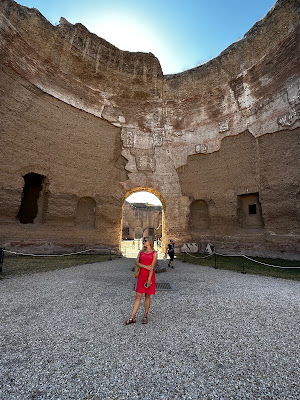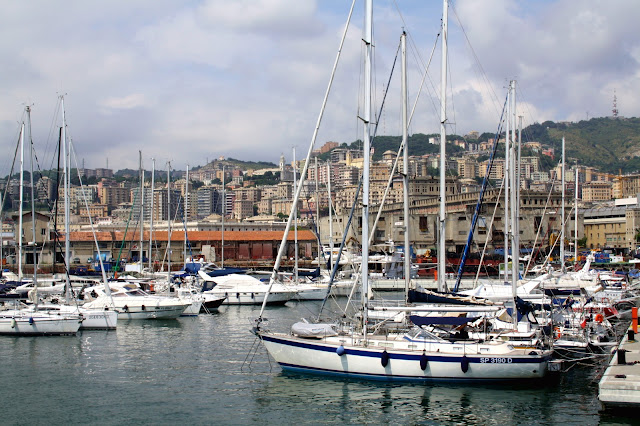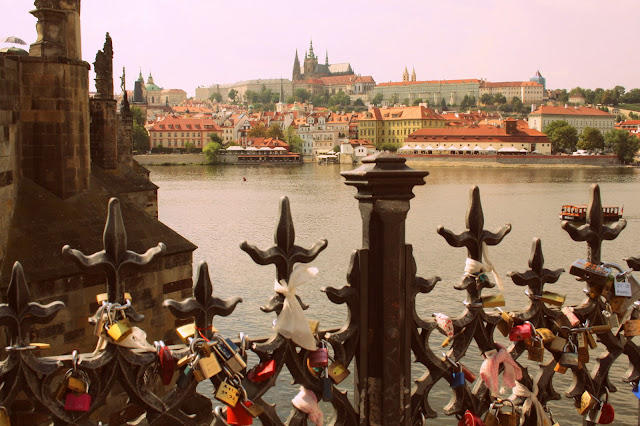Percy Shelley "na wyniosłych ruinach term Karakalli"/Percy Shelley "upon the mountainous ruins of the Baths of Caracalla"
"Shelley piszący 'Prometeusza wyzwolonego' w termach Karakalli" to obraz namalowany przez Josepha Saverna (przyjaciela Johna Keatsa) w 1845 roku. Obraz powstał ponad 20 lat po śmierci Shelleya, na zamówienie jego syna. Wizerunek poety odtworzono w oparciu o portret autorstwa Amelii Currant.
Percy Shelley odwiedził Rzym dwa razy. Pierwszy raz w listopadzie 1818 roku (czytaj tutaj), drugim razem wiosną 1819 roku. To wtedy termy Karakalli stały się jednym z jego ulubionych zakątków Wiecznego Miasta.
"Shelley Composing 'Prometheus Unbound' in the Baths of Caracalla" is a painting by Joseph Savern (a friend of John Keats). He painted it at the request of Shelley's son in 1845, so more than 20 years after Shelley's death. The image of the poet was based on a portrait by Amelia Currant.
Percy Shelley visited Rome twice. The first time in November 1818 (read here) the second time in the spring of 1819. It was then, that the Baths of Caracalla became one of his favorite corners of the Eternal City.
Termy wybudowane za panowania cesarza Karakalli nie były zwykłym kompleksem łaźni miejskich. Oprócz basenów z zimną i gorącą wodą, znajdowała się tu siłownia, sala gier i rozrywek, liczne sklepy, biblioteka a nawet sanktuarium. Dodatkowo wszystkie pomieszczenia były bogato dekorowane - ściany i podłogi wyłożone marmurowymi płytami, czy też zdobione mozaikami. Całą przestrzeń zapełniały setki kolumn i kolosalnych posągów. Niektóre z nich teraz można podziwiać w muzeach oraz w najrozmaitszych zakątkach Rzymu. To właśnie tu spod gruzów wydobyto najsłynniejsze arcydzieła starożytności, takie jak grupa Laokoona, Herkules Farnese, czy Byk Farnezyjski.
The baths built during the reign of Emperor Caracalla were much more than an ordinary complex of city baths. Aside from swimming pools with cold and hot water, there was a gym, a games and entertainment room, numerous shops, a library and even a sanctuary. What is more, all rooms were richly decorated - walls and floors lined with marble slabs and decorated with mosaics. The entire space was filled with hundreds of columns and colossal statues. Some of them can now be admired in museums or in the different corners of Rome. It was here, that the most famous masterpieces of antiquity were recovered from the rubble, such as the Laocoön group, Hercules Farnese, and the Farnesian Bull.
Jednak tak jak teraz, podobnie za czasów Shelleya termy Karakalli były kompletną ruiną. Dla romantyków ruiny stanowiły źródło fascynacji i przerażenia. Pozostałości upadłej potęgi wywoływały zachwyt i trwogę. Stanowiły namacalny dowód na to, że żadne, choćby najpotężniejsze dzieło ludzkich rąk nie jest wieczne.
Wkrótce po przyjeździe do Rzymu w jednym z listów Shelley pisze, że oprócz Koloseum „najważniejszym zabytkiem starożytności, mającym formę ruiny, są Termy Karakalli. Składają się one z sześciu ogromnych komór, wysokich na ponad 200 stóp, z których każda obejmuje ogromną przestrzeń przypominającą pole. Ponadto znajduje się tu wiele wież, labiryntów i zakamarków, ukrytych pod chwastami i oplecionych przez dziko rosnący bluszcz. Żadne spustoszenie nie było tak wzniosłe i urzekające. Pionowa ściana ruin jest przedzielona stromymi wyrwami wypełnionymi kwitnącymi krzewami, których grube, skręcone korzenie wplecione są w szczeliny kamieni."
However, as now, also in Shelley's time, the Baths of Caracalla were in a state of complete ruin. For the Romantics, ruins were a source of awe. The remains of the fallen power evoked fear and delight. It was tangible proof that no work of human hands, no matter how powerful, can withstand the test of time.
Shortly after arriving in Rome, in one of his letters Shelley writes, that apart from the Colosseum the "most considerable relic of antiquity, considered as a ruin, is the Thermae of Caracalla. These consist of six enormous chambers, above 200 feet in height, and each inclosing a vast space like that of a field. There are, in addition, a number of towers and labyrinthine recesses, hidden and woven over by the wild growth of weeds and ivy. Never was any desolation more sublime and lovely. The perpendicular wall of ruin is cloven into steep ravines filled up with flowering shrubs, whose thick twisted roots are knotted in the rifts of the stones."
 | |
|
Choć dziś nie brak tu turystów to na początku XIX wieku w te okolice zaglądało najwyżej kilku zbłąkanych wędrowców. Dla Shelleya, który nigdy nie narzekał na brak towarzystwa, spacer do term stanowił okazję do spędzenie czasu w ciszy i samotności, a co najważniejsze stwarzał idealną przestrzeń do kontemplacji i zebrania myśli a także stanowił niekończące się źródło inspiracji twórczej.
Poranna wyprawa do term Karakalli była stałym punktem w rozkładzie dnia Shelleya i z czasem przybrała formę rytuału. Codziennie rano brał ze sobą notatnik, książki, pióro, zapas atramentu i wyruszał do położonych nieco na uboczu, zrujnowanych przed wiekami term. Pisał. Postępy w pracy były szybkie, już po 4 tygodniach "Prometeusz rozpętany" był praktycznie ukończony. W momentach znużenia, zagłębiał się w ruiny niczym w labirynt, doznając niemal natychmiastowego orzeźwienia.
We wstępie do Prometeusza zanotował: "Poemat ten pisałem na wyniosłych ruinach term Karakali, które pośród ukwieconych pól i gąszczy wonnych, kwitnących drzew rozprzestrzeniają się krętymi labiryntami na potężnych murach i zawrotnych łukach zawieszonych w powietrzu. Jasne, błękitne niebo Rzymu i działanie rześkiej, budzącej się wiosny w tym boskim klimacie, i nowe życie, które przepaja duszę aż do omroczenia, były natchnieniem tego dramatu."
Although nowadays there is planty of tourists here, at the beginning of the 19th century, only a few stray travelers visited this area. For Shelley, who never complained about the lack of company, a walk to the baths was an opportunity to spend time in silence and solitude, and most importantly, it created an ideal space for contemplation and gathering thoughts, and was an inexhaustible source of creative inspiration.
The morning trip to the baths of Caracalla was a mandatory point in Shelley's daily schedule and over time it took the form of a ritual. Each day, equipped with a notebook, books, a pen, and a supply of ink, he set off to the ruined thermal baths, located a bit away from the city center. He has been writing. Progress in the work was rapid, after only 4 weeks, "Prometheus Unleashed" was practically completed. In moments of weariness, he delved into the ruins as if into a maze, experiencing almost immediate refreshment.
In the 'Preface' to the "Prometheus" he wrote: "This Poem was chiefly written upon the mountainous ruins of the Baths of Caracalla, among the flowery glades, and the thickets of odoriferous blossoming trees, which are extended in ever winding labyrinths upon its immense platforms and dizzy arches suspended in the air. The bright blue sky of Rome, and the effect of the vigorous awakening spring in that divinest climate, and the new life with which it drenches the spirits even to intoxication, were the inspiration of this drama."
"Jednak jest coś jeszcze ciekawszego. - Shelley kontynuuje wywód we wspomnianym liście - W jednej z przypór, podtrzymującej ogromny i wysoki łuk,(...), znajdują się rozpadające pozostałości starożytnych krętych schodów, których boki są w wielu miejscach otwarte w stronę przepaści. Wspinając się po nich, docierasz na sam szczyt tego stosu gruzów. Po wszystkich stronach rosną gęste, splątane dzikie krzewy mirtu, lauru i kwitnącego wawrzynu, którego białe kwiaty właśnie się rozwinęły, dzika figa i tysiąc bezimiennych roślin zasianych przez wędrowne wiatry"
"Ze środka wznoszą się te stosy i szczyty, które oglądane z dołu przypominają góry. W jednym miejscu błądzisz wzdłuż wąskiego pasa porośniętych chwastami ruin, z jednej strony bezmiar ziemi i nieba, z drugiej wąska przepaść, ograniczona łukiem ogromnych rozmiarów, otoczona wielobarwnym listowiem i kwiatami."
"But the most interesting effect remains. - Shelley continues his argument later in the letter - In one of the buttresses, that supports an immense and lofty arch, (...) are the crumbling remains of an antique winding staircase, whose sides are open in many places to the precipice. This you ascend, and arrive on the summit of these piles. There grow on every side thick entangled wildernesses of myrtle, and the myrletus, and bay, and the flowering laurustinus, whose white blossoms are just developed, the wild fig, and a thousand nameless plants sown by the wandering winds"
"From the midst rise those pinnacles and masses, themselves like mountains, which have been seen from below. In one place you wind along a narrow strip of weed- grown ruin, on one side is the immensity of earth and sky, on the other a narrow chasm, which is bounded by an arch of enormous size, fringed by the many-coloured foliage and blossoms."
"Przyjedź do Rzymu. Jest to scena, która przewyższa ekspresję; której słowa nie są w stanie oddać. Jeszcze dalej, błądząc pośród na wpół rozbitych piramid, ścieżką wiodącą przez kwitnący zagajnik, dochodzi się do małej omszałej łączki, otoczonej dzikimi krzewami; jest porośnięta zawilcami, lakami i fiołkami, których łodygi przebijają przez gwiaździsty mech, i promiennymi niebieskimi kwiatami, których nazw nie znam, a które rozpraszają w powietrzu najwspanialszy zapach, który gdy odpoczywasz w cieniu ruiny, wywołuje wrażenie zmysłowego upojenia, jak dźwięki słodkiej muzyki. Ścieżki wciąż wiją się, tworząc zawiłe zakręty, kolejne labirynty, kolejne łąki, głębokie zadrzewione doliny, wysokie skały i straszliwe przepaści. Kiedy powiem Ci, że te ruiny zajmują kilka akrów, i że ścieżki po szczytach ruin przekraczają co najmniej o połowę ich długość, Twoja wyobraźnia wypełni wszystko to, czego nie jestem w stanie wyrazić na temat tej zdumiewającej sceny."
"Come to Rome. It is a scene by which expression is overpowered ; which words cannot convey. Still further, winding up one half of the shattered pyramids, by the path through the blooming copse-wood, you come to a little mossy lawn, surrounded by the wild shrubs ; it is overgrown with anemones, wall- flowers, and violets, whose stalks pierce the starry moss, and with radiant blue flowers, whose names I know not, and which scatter through the air the divinest odour, which, as you recline under the shade of the ruin, produces sensations of voluptuous faintness, like the combinations of sweet music. The paths still wind on, threading the perplexed windings, other labyrinths, other lawns, and deep dells of wood, and lofty rocks, and terrific chasms. When I tell you that these ruins cover several acres, and that the paths above penetrate at least half their extent, your imagination will fill up all that I am unable to express of this astonishing scene."
Do tego raju spiesz, o spiesz do Romy,
Do tej pustyni, miasta i mogiły,
Gdzie szczyty ruin sterczą, jak gór złomy:
Gdzie dla Zniszczenia obnażonej siły
Przewonne krzewy bujny wian uwiły;
Spiesz, aż duch miejsca twoje stopy drżące
Wstrzyma, gdzie ogród przywita cię miły,
Gdzie, jak śmiech dziecka, nad śmiercią płonące
Zdrój światła leją kwiaty po zielonej łące.
[fragment poematu „Adonais”, tłum. J. Kasprowicz]
Go thou to Rome—at once the Paradise,
The grave, the city, and the wilderness;
And where its wrecks like shatter'd mountains rise,
And flowering weeds, and fragrant copses dress
The bones of Desolation's nakedness
Pass, till the spirit of the spot shall lead
Thy footsteps to a slope of green access
Where, like an infant's smile, over the dead
A light of laughing flowers along the grass is spread;
[fragment of the poem „Adonais”]




















Komentarze
Prześlij komentarz